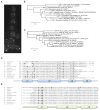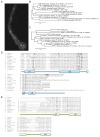Centromeres of filamentous fungi
- PMID: 22752455
- PMCID: PMC3409310
- DOI: 10.1007/s10577-012-9290-3
Centromeres of filamentous fungi
Abstract
How centromeres are assembled and maintained remains one of the fundamental questions in cell biology. Over the past 20 years, the idea of centromeres as precise genetic loci has been replaced by the realization that it is predominantly the protein complement that defines centromere localization and function. Thus, placement and maintenance of centromeres are excellent examples of epigenetic phenomena in the strict sense. In contrast, the highly derived "point centromeres" of the budding yeast Saccharomyces cerevisiae and its close relatives are counter-examples for this general principle of centromere maintenance. While we have learned much in the past decade, it remains unclear if mechanisms for epigenetic centromere placement and maintenance are shared among various groups of organisms. For that reason, it seems prudent to examine species from many different phylogenetic groups with the aim to extract comparative information that will yield a more complete picture of cell division in all eukaryotes. This review addresses what has been learned by studying the centromeres of filamentous fungi, a large, heterogeneous group of organisms that includes important plant, animal and human pathogens, saprobes, and symbionts that fulfill essential roles in the biosphere, as well as a growing number of taxa that have become indispensable for industrial use.
Conflict of interest statement
The authors have no conflicting interests.
Figures








Similar articles
-
Rapid evolution of Cse4p-rich centromeric DNA sequences in closely related pathogenic yeasts, Candida albicans and Candida dubliniensis.Proc Natl Acad Sci U S A. 2008 Dec 16;105(50):19797-802. doi: 10.1073/pnas.0809770105. Epub 2008 Dec 5. Proc Natl Acad Sci U S A. 2008. PMID: 19060206 Free PMC article.
-
Fungi as models of centromere innovation: from DNA sequence to 3-dimensional arrangement.Chromosome Res. 2025 Aug 11;33(1):18. doi: 10.1007/s10577-025-09775-1. Chromosome Res. 2025. PMID: 40785015 Review.
-
Diversity in requirement of genetic and epigenetic factors for centromere function in fungi.Eukaryot Cell. 2011 Nov;10(11):1384-95. doi: 10.1128/EC.05165-11. Epub 2011 Sep 9. Eukaryot Cell. 2011. PMID: 21908596 Free PMC article. Review.
-
Evolutionary insights into the role of the essential centromere protein CAL1 in Drosophila.Chromosome Res. 2012 Jul;20(5):493-504. doi: 10.1007/s10577-012-9299-7. Chromosome Res. 2012. PMID: 22820845
-
Heterochromatin and RNAi regulate centromeres by protecting CENP-A from ubiquitin-mediated degradation.PLoS Genet. 2018 Aug 8;14(8):e1007572. doi: 10.1371/journal.pgen.1007572. eCollection 2018 Aug. PLoS Genet. 2018. PMID: 30089114 Free PMC article.
Cited by
-
Chromosome assembled and annotated genome sequence of Aspergillus flavus NRRL 3357.G3 (Bethesda). 2021 Aug 7;11(8):jkab213. doi: 10.1093/g3journal/jkab213. G3 (Bethesda). 2021. PMID: 34849826 Free PMC article.
-
The stem rust fungus Puccinia graminis f. sp. tritici induces centromeric small RNAs during late infection that are associated with genome-wide DNA methylation.BMC Biol. 2021 Sep 15;19(1):203. doi: 10.1186/s12915-021-01123-z. BMC Biol. 2021. PMID: 34526021 Free PMC article.
-
Comparative genomics of Cryptococcus and Kwoniella reveals pathogenesis evolution and contrasting karyotype dynamics via intercentromeric recombination or chromosome fusion.bioRxiv [Preprint]. 2024 Jan 13:2023.12.27.573464. doi: 10.1101/2023.12.27.573464. bioRxiv. 2024. Update in: PLoS Biol. 2024 Jun 6;22(6):e3002682. doi: 10.1371/journal.pbio.3002682. PMID: 38234769 Free PMC article. Updated. Preprint.
-
Investigating the origin of subtelomeric and centromeric AT-rich elements in Aspergillus flavus.PLoS One. 2023 Feb 9;18(2):e0279148. doi: 10.1371/journal.pone.0279148. eCollection 2023. PLoS One. 2023. PMID: 36758027 Free PMC article.
-
Gene Expression and Chromatin Modifications Associated with Maize Centromeres.G3 (Bethesda). 2015 Nov 12;6(1):183-92. doi: 10.1534/g3.115.022764. G3 (Bethesda). 2015. PMID: 26564952 Free PMC article.
References
-
- Allshire RC. Centromeres, checkpoints and chromatid cohesion. Curr Opin Genet Dev. 1997;7:264–273. - PubMed
Publication types
MeSH terms
Substances
Grants and funding
LinkOut - more resources
Full Text Sources
Medical
Miscellaneous

